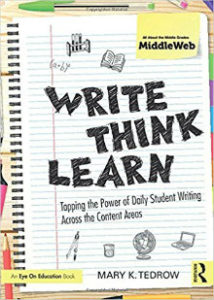How to Add Daily Writing to Your Content Area
Write, Think, Learn: Tapping Into the Power of Daily Student Writing Across the Content Areas
By Mary K. Tedrow
(Routledge/MiddleWeb, 2018 – Learn more)
 Reviewed by Ariel Sacks
Reviewed by Ariel Sacks
Why I Love This Book
Write, Think, Learn is my new favorite resource for teaching writing. It’s short, only 150 pages, and enjoyable to read. It’s highly practical and classroom-based. It aligns with my goals as a teacher to honor student thinking, and it exudes the wisdom of its author, Mary Tedrow, a National Board Certified English teacher and director of the Shenandoah Valley Writing Project.
Beyond her own teaching experience, Tedrow thoughtfully weaves ideas from a diversity of other sources (Peter Elbow, Kelly Gallagher, and Robert Pirsig, to name just a few) throughout the book. Literally every page gives me something to think about, and I don’t often feel that way when I read practice-based professional development books.
 What this book does is teach us how to cultivate our students’ individual relationships with writing through a low stakes journal-like approach using a Daybook. The Daybook becomes a safe space for students’ authentic writing and thinking that feeds the other kinds of writing and the curricular objectives of the discipline being studied.
What this book does is teach us how to cultivate our students’ individual relationships with writing through a low stakes journal-like approach using a Daybook. The Daybook becomes a safe space for students’ authentic writing and thinking that feeds the other kinds of writing and the curricular objectives of the discipline being studied.
Write Think Learn has already begun to transform my teaching. I think most English teachers have tried some version of journaling with our students, but Tedrow has helped me take it to the next level, creating a full-on independent writing thread for my ELA classes, without disrupting the rest of my curriculum.
For content area teachers (you need this too) Tedrow shows how the Daybook builds students’ critical thinking and curiosity while supporting literacy – which content teachers are always asked to do, but often without a clear idea of how to go about it.
What’s In the Book
The book begins with an argument for daily writing. Tedrow gives us permission to skip this chapter if we’re already sold on starting a daily writing practice, which I thought was kind; however, I really enjoyed reading it anyway. This chapter helped deepen my understanding of the value of regular writing practice for students, and especially the relationship between writing and thinking – and I’m speaking as an experienced teacher and published writer myself! In other words, read this chapter.
Chapter 2 is about how to launch the Daybook, and more generally, how to motivate students to “accept the writing challenge.” I appreciated the practical detail on how to set up a Daybook and how to build student anticipation for writing. There is also a fascinating lesson about the four writing characters, who “inhabit [our] mental lives,” which definitely caught my students’ interest and helped them think about the different skills involved in writing.
In fact, Mary Tedrow’s advice for launching the Daybook worked so well in my eighth grade classes, I wrote this article about it for Education Week. The idea is to build the habit of daily writing over at least 21 days. Once the habit is built, we can be more flexible in how we use it.
Chapter 3 is about creating prompts that invite genuine engagement from students. This whole chapter would be helpful for teachers of any subject, regardless of whether they adopt the Daybook structure wholesale. Tedrow explains why the way we phrase our prompts – how we incorporate choice and personal connection, especially – is crucial to whether students choose to meet the challenge or avoid it.
Chapter 4 is about facilitating student reflection and goal setting (looking back and looking forward, as she describes it). Pausing and making space for this kind of thinking, Tedrow argues, helps students gain a sense of their own learning and develop the growth mindset that makes such a difference for students. I found the “response journals” to use after introducing new content (literary or otherwise) helpful because they are protocols that can be practiced with any text.
I love Chapter 5 because Tedrow delves into the question of how to help students explore their own thinking, when original thinking is often not what they’re used to writing in school. My mentor, Madeleine Ray, always says that the purpose of school should be for students to “discover the power of their minds.” Tedrow’s point that “We cannot expect students to recognize and use critical thinking skills without clearing out a practice space” is very real. She offers 11 specific exercises for helping students to discover their own thinking.
Chapter 6, “Writing and the Curriculum,” is about how to use writing (i.e. student thinking) as the engine for learning content. She recognizes that this represents a paradigm shift for many teachers, and she offers 12 activities that support this strategy without requiring a lot of extra time. English teachers will love the last section, in which Tedrow (a veteran English teacher) shares 17 activities for teaching English concepts, such as irony and archetype. It’s a goldmine!
In Chapter 7, “Why Are These Essays So Hard To Read?” we learn methods for supporting students to collect their ideas and identify gaps before drafting major writing pieces. The exercises in this chapter help to seriously increase the rigor of student writing, but still utilize low-stakes supportive pre-writing tasks, rather than just setting a higher bar and pressuring students to meet it, which is more often the approach.
Finally, Chapter 8 addresses the question of grading, moving away from “carrots and sticks” toward limiting grading as much as possible (yes, please), and including students in the process when assessment is necessary. Sharing writing, for example, is a formative assessment and can be its own intrinsic reward for students. A “Daybook Audit” protocol for students to self assess their writing patterns over the course of a semester is included in this chapter and is high on my “to try” list right now.
Sparked
There is so much to learn from this book. As I said before, every page sparks my thinking. I’m super excited about the changes I’ve made so far – adopting the Daybook and cultivating a habit of daily independent writing for my students.
It will take me a few years of experimenting to fully integrate all the book offers into my existing English curriculum, but Mary Tedrow’s masterful teaching is just the guide I’m looking for. I can’t imagine any teacher reading this without walking away inspired to cultivate their students’ writing in new ways.
Ariel Sacks @arielsacks is an eighth grade English teacher in New York City and a widely published education writer. She is the author of Whole Novels For the Whole Class: A Student Centered Approach and a columnist at Education Week. She supports teachers around the country to implement student centered teaching methods in English Language Arts.


































I really liked the way you described this book. The idea of the Daybook is great! Especially the fact that one of the goals of the book is to improve the students’ thinking (not just their writing skills).
I am also interested in Chapter 7! Thank you for this review, I will definitely read it. I wish I had heard of it before.